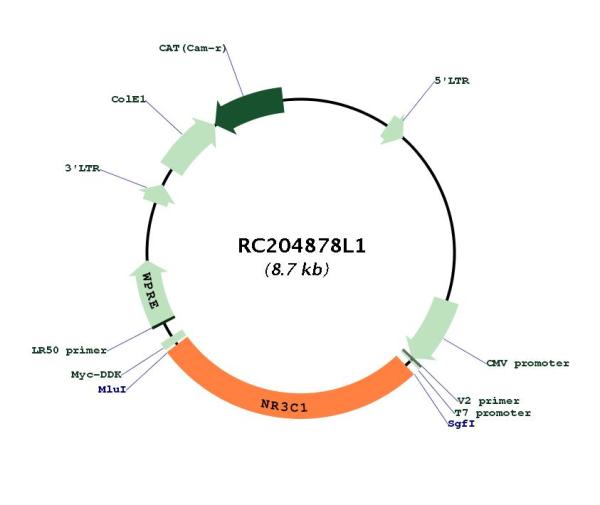Glucocorticoid Receptor (NR3C1) (NM_001018074) Human Tagged Lenti ORF Clone
CAT#: RC204878L1
- LentiORF®
Lenti ORF clone of Human nuclear receptor subfamily 3, group C, member 1 (glucocorticoid receptor) (NR3C1), transcript variant 2, Myc-DDK-tagged
"NM_001018074" in other vectors (6)
Specifications
| Product Data | |
| Type | Human Tagged ORF Clone |
| Tag | Myc-DDK |
| Symbol | Glucocorticoid Receptor |
| Synonyms | GCCR; GCR; GCRST; GR; GRL |
| Vector | pLenti-C-Myc-DDK |
| E. coli Selection | Chloramphenicol (34 ug/mL) |
| Mammalian Cell Selection | None |
| Sequence Data |
The ORF insert of this clone is exactly the same as(RC204878).
|
| Restriction Sites |
SgfI-MluI
Cloning Scheme for this gene
Plasmid Map

|
| ACCN | NM_001018074 |
| ORF Size | 2331 bp |
| OTI Disclaimer | Due to the inherent nature of this plasmid, standard methods to replicate additional amounts of DNA in E. coli are highly likely to result in mutations and/or rearrangements. Therefore, OriGene does not guarantee the capability to replicate this plasmid DNA. Additional amounts of DNA can be purchased from OriGene with batch-specific, full-sequence verification at a reduced cost. Please contact our customer care team at custsupport@origene.com or by calling 301.340.3188 option 3 for pricing and delivery. The molecular sequence of this clone aligns with the gene accession number as a point of reference only. However, individual transcript sequences of the same gene can differ through naturally occurring variations (e.g. polymorphisms), each with its own valid existence. This clone is substantially in agreement with the reference, but a complete review of all prevailing variants is recommended prior to use. More info |
| OTI Annotation | This clone was engineered to express the complete ORF with an expression tag. Expression varies depending on the nature of the gene. |
| Product Components | The ORF clone is ion-exchange column purified and shipped in a 2D barcoded Matrix tube containing 10ug of transfection-ready, dried plasmid DNA (reconstitute with 100 ul of water). |
| Reconstitution | 1. Centrifuge at 5,000xg for 5min. 2. Carefully open the tube and add 100ul of sterile water to dissolve the DNA. 3. Close the tube and incubate for 10 minutes at room temperature. 4. Briefly vortex the tube and then do a quick spin (less than 5000xg) to concentrate the liquid at the bottom. 5. Store the suspended plasmid at -20°C. The DNA is stable for at least one year from date of shipping when stored at -20°C. |
| Reference Data | |
| RefSeq | NM_001018074.1, NP_001018084.1 |
| RefSeq Size | 6614 bp |
| RefSeq ORF | 2334 bp |
| Locus ID | 2908 |
| UniProt ID | P04150 |
| Cytogenetics | 5q31.3 |
| Protein Families | Druggable Genome, Nuclear Hormone Receptor, Transcription Factors |
| Protein Pathways | Neuroactive ligand-receptor interaction |
| MW | 85.5 kDa |
| Gene Summary | This gene encodes glucocorticoid receptor, which can function both as a transcription factor that binds to glucocorticoid response elements in the promoters of glucocorticoid responsive genes to activate their transcription, and as a regulator of other transcription factors. This receptor is typically found in the cytoplasm, but upon ligand binding, is transported into the nucleus. It is involved in inflammatory responses, cellular proliferation, and differentiation in target tissues. Mutations in this gene are associated with generalized glucocorticoid resistance. Alternative splicing of this gene results in transcript variants encoding either the same or different isoforms. Additional isoforms resulting from the use of alternate in-frame translation initiation sites have also been described, and shown to be functional, displaying diverse cytoplasm-to-nucleus trafficking patterns and distinct transcriptional activities (PMID:15866175). [provided by RefSeq, Feb 2011] |
Documents
| Product Manuals |
| FAQs |
| SDS |
Resources
Other Versions
| SKU | Description | Size | Price |
|---|---|---|---|
| RC204878 | NR3C1 (Myc-DDK-tagged)-Human nuclear receptor subfamily 3, group C, member 1 (glucocorticoid receptor) (NR3C1), transcript variant 2 |
USD 1,067.00 |
|
| RC204878L2 | Lenti ORF clone of Human nuclear receptor subfamily 3, group C, member 1 (glucocorticoid receptor) (NR3C1), transcript variant 2, mGFP tagged |
USD 1,367.00 |
|
| RC204878L3 | Lenti ORF clone of Human nuclear receptor subfamily 3, group C, member 1 (glucocorticoid receptor) (NR3C1), transcript variant 2, Myc-DDK-tagged |
USD 1,367.00 |
|
| RC204878L4 | Lenti ORF clone of Human nuclear receptor subfamily 3, group C, member 1 (glucocorticoid receptor) (NR3C1), transcript variant 2, mGFP tagged |
USD 1,367.00 |
|
| RG204878 | NR3C1 (tGFP-tagged) - Human nuclear receptor subfamily 3, group C, member 1 (glucocorticoid receptor) (NR3C1), transcript variant 2 |
USD 1,267.00 |
|
| SC302161 | NR3C1 (untagged)-Human nuclear receptor subfamily 3, group C, member 1 (glucocorticoid receptor) (NR3C1), transcript variant 2 |
USD 1,068.00 |
{0} Product Review(s)
Be the first one to submit a review






























































































































































































































































 Germany
Germany
 Japan
Japan
 United Kingdom
United Kingdom
 China
China



